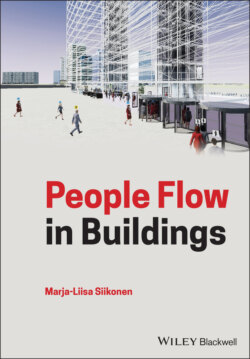Читать книгу People Flow in Buildings - Marja-Liisa Siikonen - Страница 9
На сайте Литреса книга снята с продажи.
Оглавление
Preface
The motivation for publishing this book, ‘People Flow in Buildings’, is that the currently available elevator traffic books cover only the elevator technology and hardware from the 1970s. Some updates to these books on new devices have been made but they describe the hardware, the calculation methods for steady states and simple extreme situations, such as morning up‐peak traffic where 100% of occupants are assumed to enter the building.
In 1980–1990, the first software‐based embedded control systems were introduced in elevators. This book will concentrate extensively on the current situation where a lot of elevator equipment has been replaced by software. The fast evolution of microprocessors has enabled the utilization of mathematical optimization methods in control systems and communication between elevator components through software protocols. The technology of elevators and transportation devices has developed so quickly that it is hard to find up‐to‐date information on traffic design in buildings in one package.
The first elevator traffic simulation results using real control software were published in the beginning of the 1990s. With simulation, we can analyse mixed traffic situations in buildings defined according to architectural drawings. Simulation studies reveal elevator performance and passenger service level in a more realistic way in dynamically changing traffic situations. Planned transportation devices and their control systems can be studied and justified at the architectural design stage.
This book gives a starting point for selecting proper transportation equipment for new buildings and for modernization. It gives insight into making passenger journeys pleasant and smooth in buildings. The transportation devices are described in detail from the functionality and software perspective than the hardware itself. The book is targeted to software designers in companies and universities, as well as elevator consultants, manufacturers and architects.
I thank KONE Corporation for the encouragement to write this book. Especially, I want to thank Mr John Simon and Mr Samu Salmelin for their support. I am grateful to Dr Janne Sorsa, Dr Juha‐Matti Kuusinen, Mr Henri Hakonen and Mr Mirko Ruokokoski for reviewing the text. Also, my sincere thanks to Mr Rick Barker, Dr Bruce Powell and Dr Richard Peters and all others who have commented the text. Finally, I thank Mr Nigel Kimberley, as well as the Wiley Blackwell personnel, Mr Todd Green, Mrs Amy Odum, Mrs Karthika Sridharan and Mr Rajesh Kathamuthu for their contribution in finalizing the book.
